Movie Review By: SFAM
Year: 1995
Directed by: Peter Chung & Howard Baker
Written by: Peter Chung et. al.
IMDB Reference
Degree of Cyberpunk Visuals: Very High
Correlation to Cyberpunk Themes: High
Key Cast Members:
Æon Flux: Denise Poirier (voice)
Trevor Goodchild: John Rafter Lee (voice)
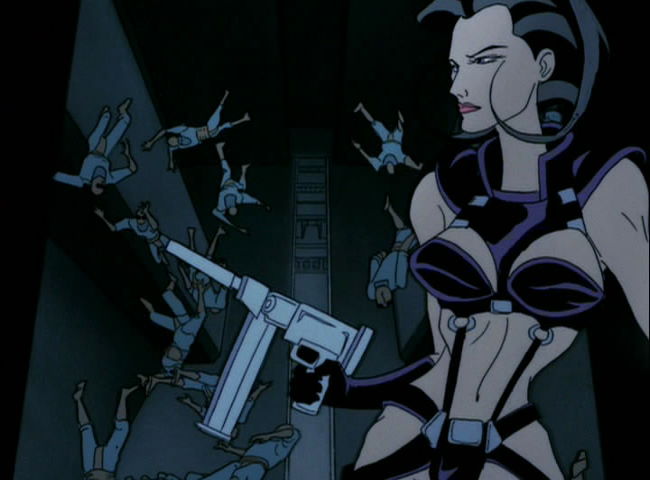
Overview: Aeon-Flux, the brainchild of Peter Chung (also the writer/director of the terrific Animatrix short, “Matriculated”), is one of the really innovative and unique animated shows to come out of the United States. We really have to thank MTV for allowing this show to get produced, and then, after realizing that they just couldn’t control it, for letting it go on unfettered for a second season. Aeon-Flux is not meant to be a coherent whole – this postmodern cyberpunk show is as nihilistic as they come.
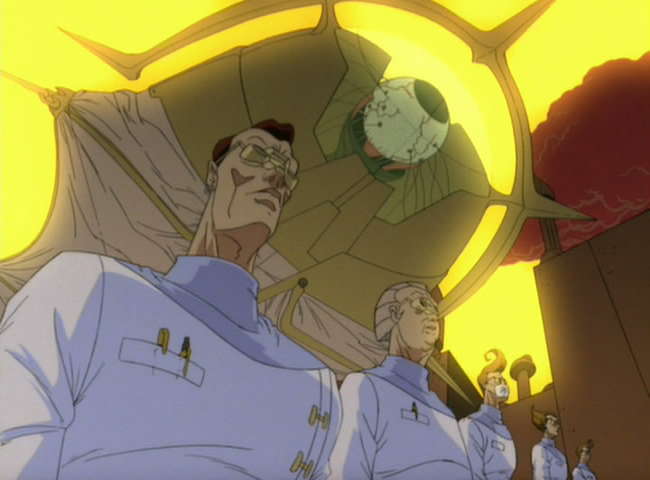
The Story: Aeon Flux takes place in a truly bizarre near-future setting, in which genetic engineering, body modifications, and excessive self-gratification are the norm – yet these extremes take place in a controlled surveillance society. Nearly all events take place in the utopian city, Bregna, which is controlled by a supreme oligarchy. Trevor (voiced by Vampire Hunter D’s John Rafter Lee), one of the two central characters, is a prototypical mad scientist who, at first seems to have little regard for anything other than his own perverted desires. As the show goes on, we find that he is in fact truly besotted with Aeon Flux, who, in many ways is his complete opposite. Aeon Flux (voiced by Denise Poirier) represents the forces of anarchy, and is continually involved in fucking up Trevor’s carefully laid scheming. Unfortunately for Aeon, she too cannot resist Trevor’s guile, which just as often, leads to her downfall.
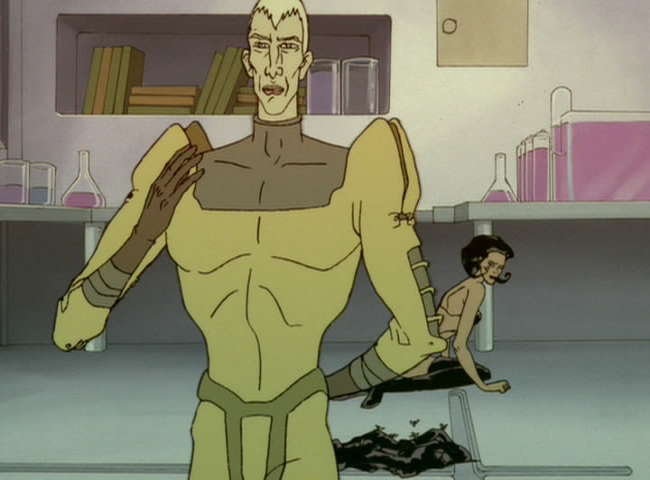
Virtually every episode is different in Aeon Flux, but all of them deal with a strange, fast-paced plot that deals with espionage in some way. Episodes usually have the feel of a chess match, where Aeon and Trevor match wits over completely strange and esoteric plots. More often than not, nobody wins. In fact, unlike most shows, the winning and ending itself is rarely important. This is not what the shows are about. More important is the mood, the feel, and the atmosphere that exudes from the visuals, the dialogue and the score.
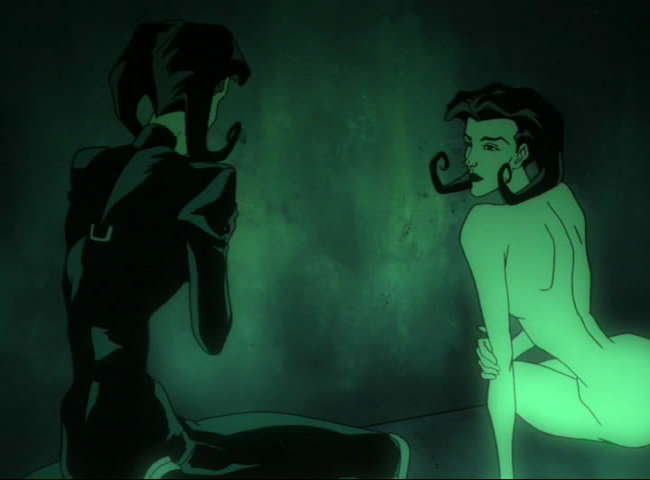
Spoiler – Aeon Flux Dies…A lot! Well, OK, it’s not really a spoiler. It’s more a fact of the show itself. Unlike most shows, in this one, the star dies regularly. Early on in the long shows, Trevor clones Aeon Flux, so thematically, there is now an infinite number of Aeons just waiting to bite the big one. And while there’s now a “rationale” for the deaths, this isn’t really the point – Aeon Flux isn’t meant to hold together that way. It’s almost as if each episode is completely it’s own show. But if she dies, rest assured it will happen in a truly innovative and gruesome way. It could be drowning in a vat of poisen, getting dropped out of a plane, being eating by bizarre genetically modified creatures, or, well, you get the idea. .

Aeon Flux – the Ultimate Anti-heroine? In many ways, Aeon Flux comes across as the ultimate anti-heroine. While she clearly knows right from wrong, and generally tries to stop the worst abuses, Aeon is an ultra-acrobatic, top-notch action/espionage heroine who works for herself. She’s just as likely to take an assassination job as she is to stop a horrid virus from killing mankind. Did I mention she’s drawn up in ultra-hot, skimpy clothes, and likes to have sex a lot? In this way, she really does qualify as a more female than female character (usually cyberpunk reserves these for cyborgs and androids). Most interestingly, because of Aeon Flux’s propensity for dying, you never know whether or not she’s going to make it through alive, or even whether she’ll complete her mission (she seems to fail almost as much as she succeeds). This really does add an excitement to the episodes.

The Love-Hate Relationship: Aeon-Flux and Trevor have a complete love-hate relationship. Even when they are bent on killing one-another, there is always sexual tension, which while often consummated, never leaves the two characters. Every episode gives us yet another chance to explore their relationship in a completely bizarre way. Trevor is definitely Aeon’s Kryptonite. More often than not, his presence alone is enough to make her botch her mission. However, this doesn’t stop Aeon from ruining most, if not all of Trevor’s take over the world plots.
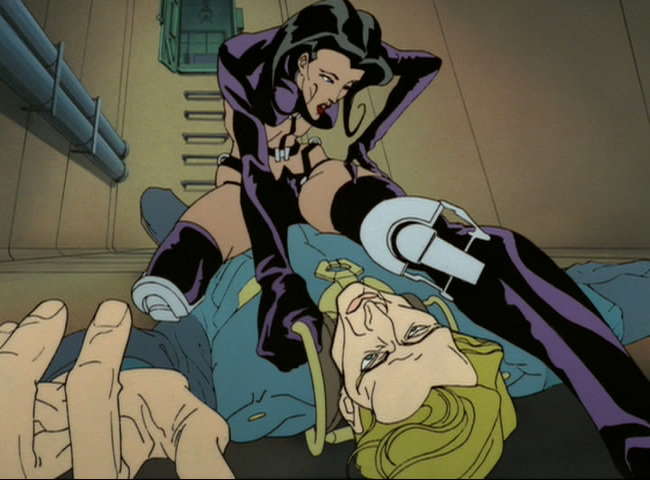
The Visuals and Cinematography: Aeon Flux gives a number of different looks as the show progresses. Perhaps my favorite are the perspective shots such as the one above. We also get lots of wide angle shots, strange close-ups, gradients, and a number of truly surrealistic sets. Unlike most cyberpunk, Aeon Flux doesn’t really adhere to a single dominating color scheme – but to the extent it does, the blues are more highlighted than the rest. Usually, each episode will have a unique theme that dictates the color choices – often they will take a color palette (oranges, greens, etc.) and detail it out in interesting ways. Some episodes are truly surreal in nature, while others are straight neo-noir. The overall goal is always to innovatively create a far-out intense atmosphere wrapped up in a tightly paced, no-nonsense near-future espionage show. More often than not it succeeds.
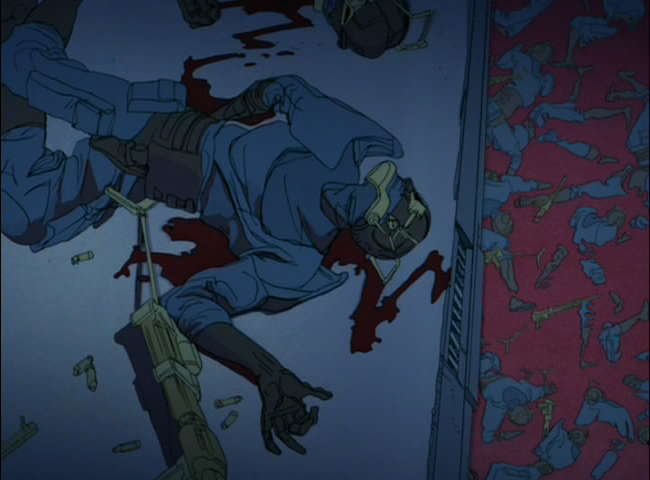
The Violence: Much to MTV’s initial chagrin, Aeon Flux is NOT a kids show. This is an adult cartoon in every way possible, including the intense violence. While the shorts are more violent than the half-hour episodes, Aeon Flux is consistently violent. There are leg amputations, deaths by gunshot, poison, insects, creatures, aliens, viruses, et cetera (often to Aeon herself!). Blood and gore are often just a scene or two away. All of this serves to strengthen the near-future but otherworldly atmosphere of Aeon Flux.
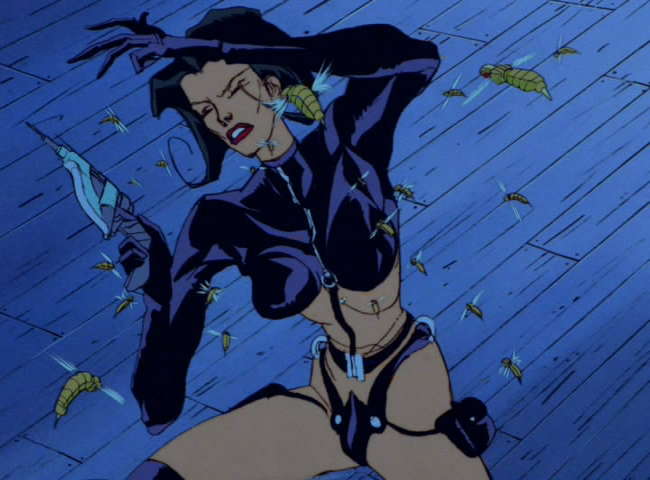
The Gadgets: Aeon-Flux is filled with gadgets of all flavors. Most common are body modifications and “biopunk” elements (just learned that word ). Body modifications include external spinal cord implants, leg jumping implants, conversions of limbs, eye implants, and various compartmentalized bodily storage areas. Genetic engineering is a huge theme in Aeon Flux, far more than the cyber-aspects. We also see repeated instances of cybernetically modified insects who’s function is to inflict a virus of some kind into a target population (Now we know where DARPA got the idea from!). Needles are also a recurring them, and show up everywhere from guns, to security implements, to, um, the operating table.
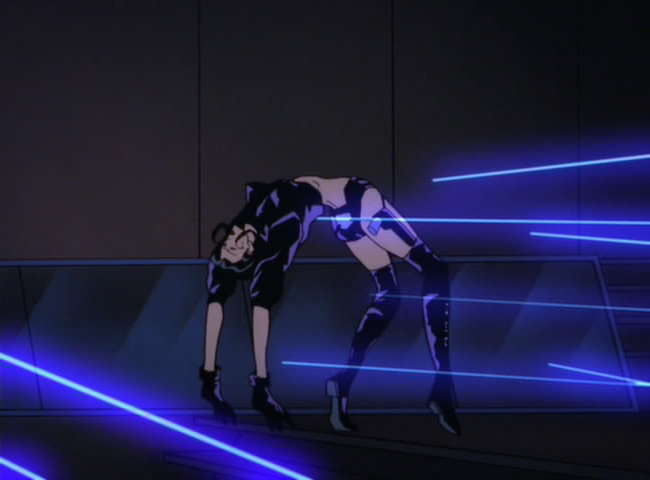
The Bottom Line: Aeon Flux is one of the really creative shows to come out of United States Television. This show validates the purpose of cable TV – we get to see talented folks like Peter Chung let lose their creative energies to produce something truly unique. And while I normally don’t spend too much time talking about the DVD features, I must on Aeon-Flux – the DVD set is flat-out terrific. I almost put it up there with Errol Flynn’s Robin Hood and The Kino edition of Metropolis as one of my favorite DVD productions of a long-lost show. The commentaries, featurettes, and extras are all terrific on the Aeon Flux DVD. If I had any qualms about whether to give Aeon Flux 8 or 9 stars, the incredible quality of the DVD set answers it for me.
More Aeon Flux Screencaps on Page 2–>>
~See movies similar to this one~
Movie Review By: SFAM
Year: 1987
Directed by: Paul Verhoeven
Written by: Edward Neumeier & Michael Miner
IMDB Reference
Degree of Cyberpunk Visuals: High
Correlation to Cyberpunk Themes: Very High
Key Cast Members:
Officer Alex J. Murphy/RoboCop: Peter Weller
Officer Anne Lewis: Nancy Allen
Dick Jones: Ronny Cox
Bob Morton: Miguel Ferrer
Clarence Boddicker (Crime Lord): Kurtwood Smith

Overview: One of the truly unique movies in the cyberpunk genre, Robocop seems to be slowly receding from our conscious. No longer (in the US) is it carried at places like Best Buy. This is truly a shame because Robocop offers us one of the best instances of near-future cyborgs on film, and in the process, raises some pretty interesting questions. One top of this, Robocop offers some really fun satire along with an in-your-face realistic violence tone throughout that only adds to its mood.
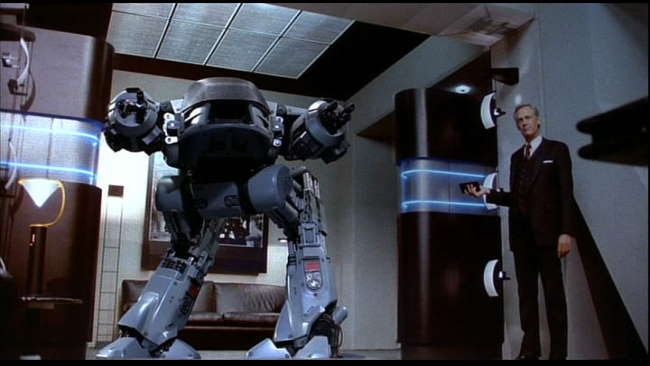
The Story: In a very near-future setting, general law and order has broken down. In the crime-ridden city of Detroit, Omni Consumer Products (OCP) has taken over the public safety duties. To cut costs, they have decided to explore options for automating the police force. One option supported by Dick Jones (Ronny Cox) the number 2 guy at OCP, involves the development of a fully automated mobile weapon system called “ED 209.” While ED 209 is an absolute badass, it screws up in the final demo and ends up peppering one of OCP’s employees in the process.
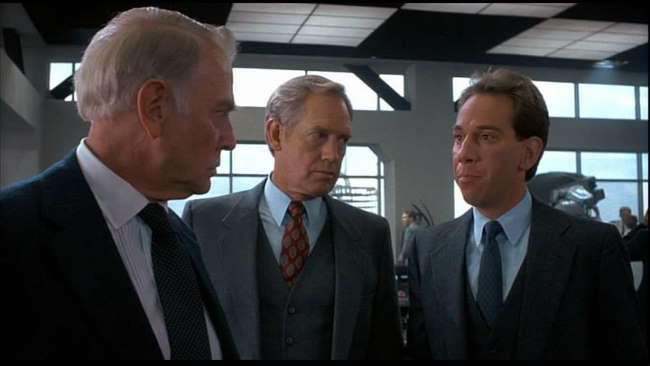
Enter up and coming executive, Bob Morton (Miguel Ferrer). Bob takes ED 209’s demise as an opportunity to convince the CEO to give the Robocop project a try. This involves taking a “just-dead” cop, and embedding the key parts of his body (brain, lungs, heart, etc.) into a robotic body that interfaces and “controls” the mental processes through controlling prime directives. Detective Murphy (played wonderfully by Peter Weller), who has just died in a gruesome death at the hands of Detroit’s crime lord (Kurtwood Smith) becomes the new “volunteer.” His memory is erased, his limbs are removed, and then becomes OCP’s corporate property as their latest innovation.
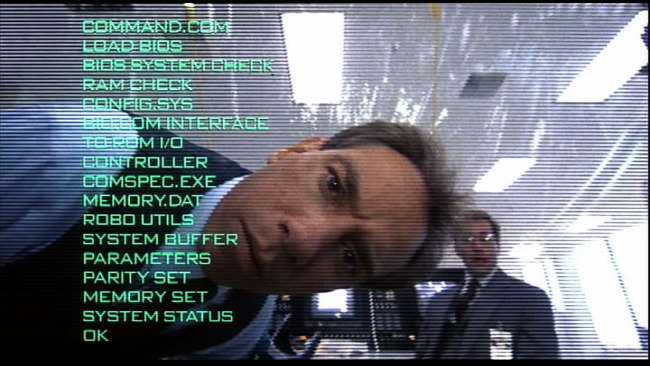
Murphy is transformed into a fully encased crime fighting machine. Robocop is released on the streets to start kicking ass. Unfortunately, Dick Jones doesn’t take his defeat gracefully, and begins to cause trouble both for Robocop’s creator, Bob Morton, and finally for Robocop. It turns out that OCP’s plan for managing detroit’s crime situation isn’t all above board, as there appears to be some linkage between OCP and Detroit’s crime lord. Robocop’s troubles get even worse as he begins to remember who he was in a past life.
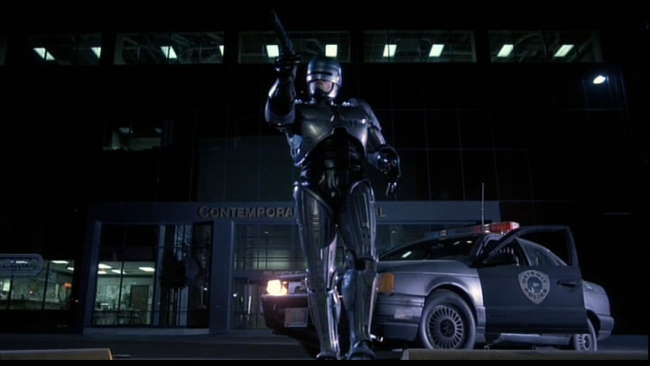
The Satire: Verhoeven is known for having an off-beat sense of satire. In a technique later used for Total Recall and Starship Troopers, Robocop does this primarily through its news reports and commercials. These, along with the corporate greed thematics transforms Robocop into a social commentary on the 80s excesses. The Commoditization of society permeates every aspect of human life in Robocop. Corporations are inherently evil and humanity is a cheap sales pitch. Like Starship Troopers, you’ll continually catch yourself smiling at the commercials and news reports, as Verhoeven really has a talent for this type of satire.
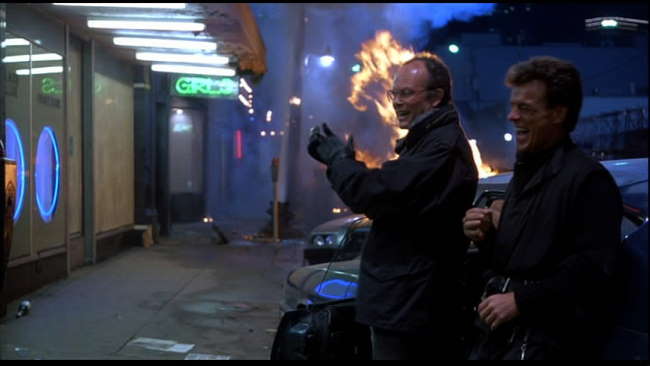
The Violence: Fair warning – Robocop is an extremely violent movie – so much so that upon its initial release, they had to cut two seconds of violence to prevent from receiving an “X” rating. Nothing is held back here, as Verhoeven continually strives for hyper-realism. We see limbs getting blown off, blood spattered faces and walls, and in-your-face gore of all varieties from beginning to end. However, the violence doesn’t stick out as a sore thumb – instead it serves to give the near-future city a nourish realism feel. In short, it works within the context of the narrative and surrounding visuals.
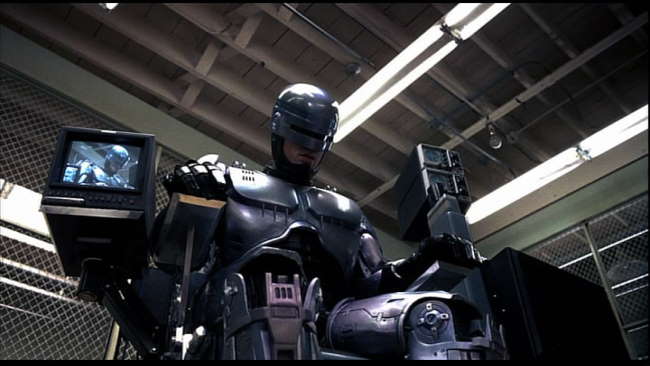
The FX and Set Designs: While Verhoeven gives us a somewhat futuristic city, he seems to err on the side of looking “normal.” We see this most clearly in the Ford Taurus police cars (which were brought in after everyone agreed the futuristic police car designs looked too tacky to be considered). However, the set designs are all wonderfully constructed, and all seem work well with one-another. The ED 209 looks terrific, and the stop-motion animation for it generally works. Robocop’s exterior design does look hoaky at first, but you eventually get used to it. On the other hand, Robocop without his helmet looks flat-out awesome.
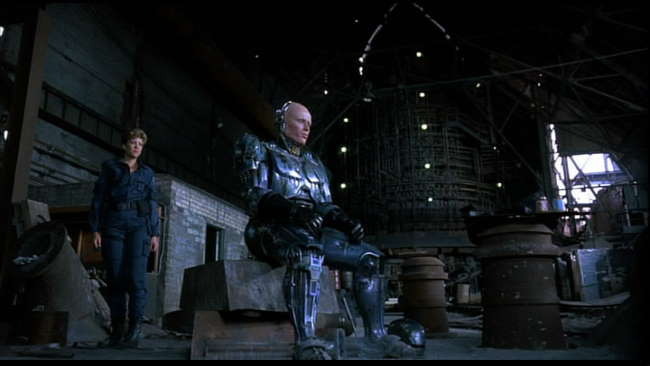
The Cyborg Questions: Robocop/Murphy give us a rich set of questions to ponder relating to cyborgs, the integration of programming with human minds, and in determining ownership after death.
- Cyborg and Humanity: As Murphy begins to realize who he was, and worse, what he’s become, the question asked is what degree of Murphy’s humanity remains? Murphy’s partner, Anne Lewis (played by Nancy Allen) serves to surface these concerns, as she still thinks that Murphy is inside somewhere. Yet, every aspect of humanity has been taken away from Robocop – he doesn’t have a home, but instead returns to a borg-like podchair at night to regenerate. Even if Robocop eventually considers himself human in some sense, it’s no longer clear what that even means. At best, Robocop is part of that strange category we call “post-human.”
- Man-machine interface – Robocop Style: Robocop gives us an interesting look at human brain-matter that has been fully integrated into a cybernetic body. Even more interesting though is the notion that external programming could limit the functioning of the human brain from controlling its new cyborg casing. If we think about it, this isn’t as far fetched as it may initially look: similar to how firewalls block “targeted” information from either entering or exiting a network, Robocop’s programming ensures the human mind adheres to the prime directives. But while the prevention part seems possible, the “directive” nature of the rules seems dubious, as does the erasing of his memory. These perhaps, are far harder to do without destroying the “cop experience” they so desired by picking Murphy in the first place.
- Dixie Flatline Construct Concerns: Similar to the Dixie Flatline Construct in Neuromancer, for all intents and purposes, Murphy is dead prior to being transformed into Robocop. At best we can consider him a zombie as his brain matter was re-animated after death. But like Dixie Flatline, he can think and perform sensemaking. Also like Dixie Flatline, he is limited by programming constraints. However, unlike Dixie Flatline, Robocop can still “feel.” So the question is this – if we develop the capability to re-animate someone’s consciousness after death, do they have the same basic human rights as they did when they were alive? Or are they the property of the corporation who revived them? Even weirder, could corpse’s estate executor (or spouse, for that matter) “sell” the corpse’s consciousness to a third party? If this is so, could your conscious be sold after the fact to pay off unpaid debts? Truly, the questions are mind-boggling!
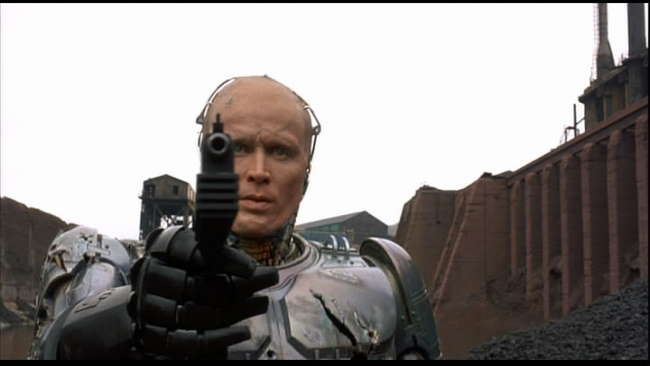
The Bottom Line: Robocop has to be considered one of the essential films of the cyberpunk genre. Some of the action scenes could have been better choreographed (a lot of the bad-guy deaths had the worthless storm trooper feel to them), but truly, the quibbles with this film are minor. Unlike the sequels, which largely come across as pathetic attempts to cash in on the original’s success, Robocop takes itself seriously from beginning to end. Because of this, it really does rise to something special. Even though Best Buy no longer considers Robocop worthy of carrying, don’t let this fool you – assuming you can stand the violence, Robocop deserves to be watched.
~See movies similar to this one~
I found this on the Livejournal Cyberpunk Collective. Looks like the DARPA, the US Military’s high-tech R&D arm is investigating the use of implanting cyborg devices in insect larvae so that when they fully develop, they’ll be cybernetic killing machines! Or, um, at least they’ll be able to snoop out the enemy.

“Darpa believes scientists can take advantage of the evolution of insects, such as dragonflies and moths, in the pupa stage.
“Through each metamorphic stage, the insect body goes through a renewal process that can heal wounds and reposition internal organs around foreign objects,” its proposal document reads.
The foreign objects it suggests to be implanted are specific micro-systems - Mems - which, when the insect is fully developed, could allow it to be remotely controlled or sense certain chemicals, including those in explosives.
The invasive surgery could “enable assembly-line like fabrication of hybrid insect-Mems interfaces”, Darpa says.”
One wonders how well butterflies will work in the Iraqi desert.
This post has been filed under News as Cyberpunk by SFAM.
Movie Review By: SFAM
Year: 1991
Directed by: Robert Rundle
Written by: Robert Rundle & Edward Sanchez
IMDB Reference
Degree of Cyberpunk Visuals: Low
Correlation to Cyberpunk Themes: Very Low
Key Cast Members:
Brent McCord: Lonnie Schuyler
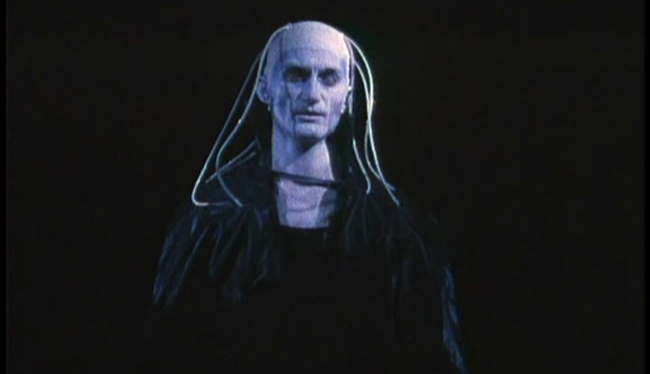
Overview: So you wanna make a cyberpunk movie but you don’t have any money, ey? No problem! As long as you have a hand-held video cam, some blue paint and a few extra malleable thin rubber tubes in your garage, you too can shoot your own cyberpunk movie! Fair warning - you might have to spring for a few bucks at Toys-R-Us for some realistic looking guns though, so try to save up a paycheck or two before getting started! Here we have an example of the lowest in cyberpunk cinema. My review will be slightly different than most in that I won’t bother hiding spoilers. Truly, you won’t care. If you watch this movie, you won’t be watching it in eager anticipation of the plot turns. While I do give Cybernator only 1 star, it really is one of those “so bad it’s good movies.” You really might be interested in dropping 6 bucks on this turkey. Think not? Read the review.
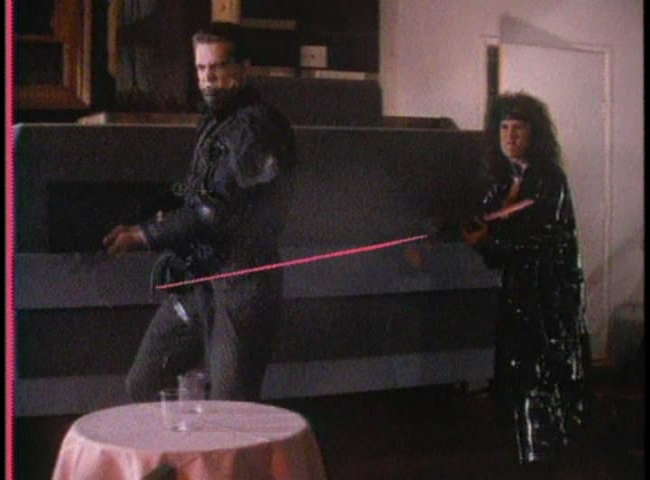
Notice the high-tech lasers! Apparently, they only had enough money to draw the pink part in twice, as its always one of two sizes. As another “feature,” whenever the laser fires, the left side of the screen has a nice pink line running down it.
The Story: The movie opens up in a complete dive strip club (a warehouse with a stage made up of black cardboard paper with shiny cut-out stars taped to it), where policeman Brent McCord (Lonnie Schuyler) comes along with his partner to see his stripper girlfriend. Unfortunately, some evil cyborgs have come to kill a US Senator, who just happens to be having sex in a sleazy room in the back (concrete walls, warehouse floor, etc.). After the evil cyborgs kill the senator, they decide to go on a rampage, randomly killing other folk. Of course, our great policeman is able to kill them, even though the cyborgs have ray guns.
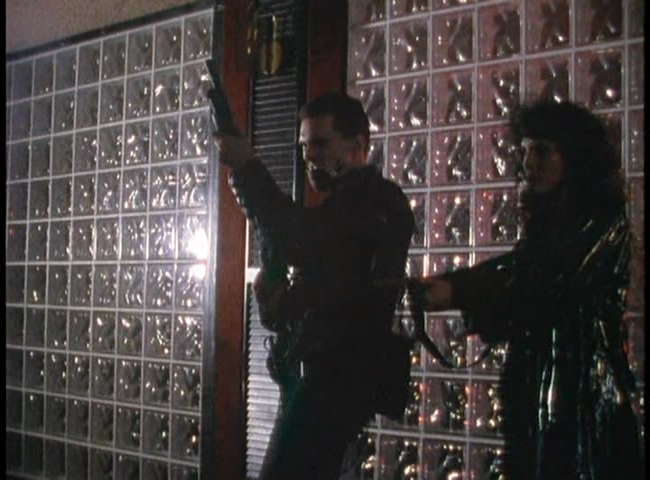
At the Morgue: the Morgue, which looks surprisingly like a made-up office room, has an Indian doctor (who actually appears to be trying to act - one of the few) who has just completed her autopsy on the two cyborgs. She states of the tough one, “He is covered with a steel titanium alloy…he is virtually indestructible. He was killed when the bullet entered the heart…”
Hmm…indestructible ey? But can be killed with a bullet through the heart? Hmmm….In any event, the morgue chick is apparently well versed in identifying military cyborgs, and proclaims that these ones are “government property, possibly from the army or something.”
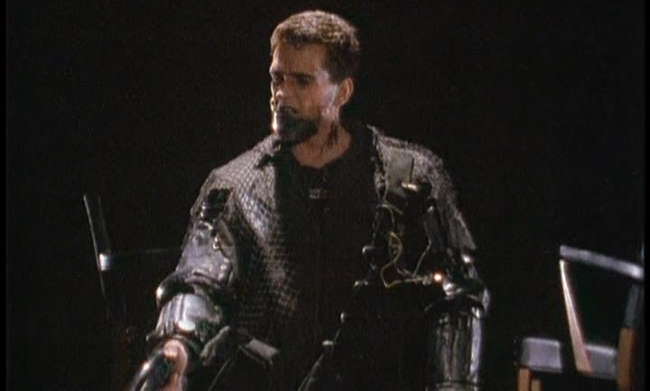
Indestructable! Unless, um, you shoot him in the heart, that is.
Our intrepid detectives then drive over to the local army building. You can tell its an army building due to the army-green colored early 70s oldsmobuick parked outside. They of course walk right into the General’s office, which is the same as the doctor’s office, but the bodies have been removed, and a flag and spaceman picture have been mounted on the wall. If this weren’t enough “reality” for you, the General’s desk has two American flags on it and a plastic toy tank to yet again convey that scary military feeling. This realism would have almost worked except for every so often, the camera veers too high and we see that the top of the general’s office is missing, and appears to be a made-up room in the same warehouse as the nudie bar.

One of the few actual “B” movie actors.
In any event, while the cops are “interrogating” the general, (who tries to throw them off-track by proclaiming that the marines are working on that stuff, not the Army - so don’t bug him!), a random scientist walks in and announces, “Here’s the new design on the Blackhawk 2000 project.” After the General quickly kicks out the scientist, we find out that the Blackhawk 2000 project is “classified!”
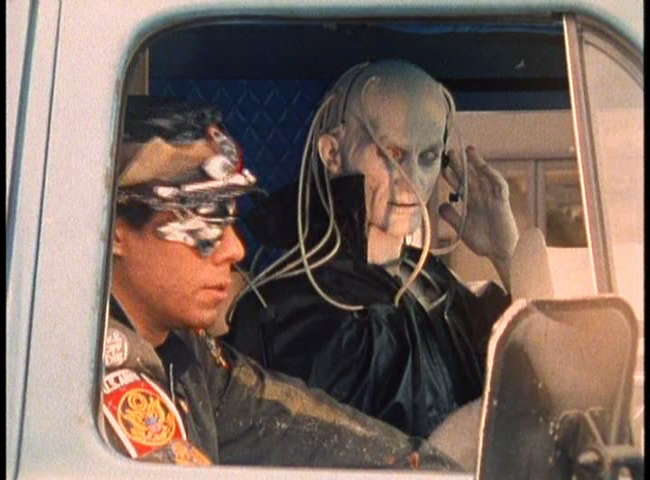
Here’s the cybernator again! Apparently, cyborgs in the future randomly gyrate from white to blue skin. I’m guessing they have “mood” skin.
Yes, ladies and gentleman, we have truly well thought-out plot points like this that permeate the movie. But wait - there’s more! That random scientist, who popped his head into the General’s office and spilled the classified program, quickly runs outside (like, RIGHT outside the General’s window) to secretly give the inside scoop to the cops. He of course wants to make sure they are really cops so he says, “You guys are cops? Show me your badges.” Being concerned that he’s meeting them right outside the General’s window, the scientist smartly tells them to meet him later that night in an abandoned alleyway. But alas, he was overheard by the Cybernator - who just happens to be waiting right next to them in a parked truck!

Interestingly, the laser shots don’t always arrive prior to the blood stains.
Unfortunately, our star’s partner gets killed by the Cybernator, so he decides to substitute his stripper girlfriend as his new partner. As the plot continues, we find that it is in fact an evil Colonel (played by an actual B actor - William Smith!) who is behind the nasty cyborgs. What’s worse, our dear police man is actually a cyborg in disguise!!!!! Versus us finding out by some cool way, say, of seeing the skin from his arm come off or something, they instead go for the ingenious method of just announcing it!

And now the military wants to kill the evil Colonel, so they capture the stripper and tell Brent that he’s a cyborg, and that he must kill the rogue cyborgs if he ever wants to see his stripper chick again. Are they guarding her at a special military base? Of course not! They appear to be holding the chick at the director’s house. Incidentally, I hope they added the puke green carpet to make us think this was an Army installation, cause if this was his actual decor, Damn!
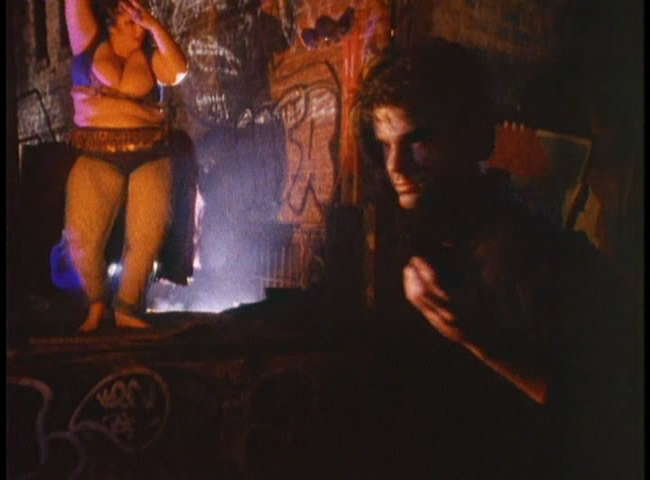
Apparently the heavy-set dancer in the street qualifies as the “underworld.”
Finally we come to the best scene of the movie - the fat cyberchick scene! This chick is doing her best at belly dancing, but apparently they forgot to give her lessons. Still, it’s the thought that counts, or so I’ve heard. I think this scene is supposed to represent the seedy underground - the place Brent goes to find out where the bad guys are. There’s nothing special here, but the line of the movie - it’s priceless.
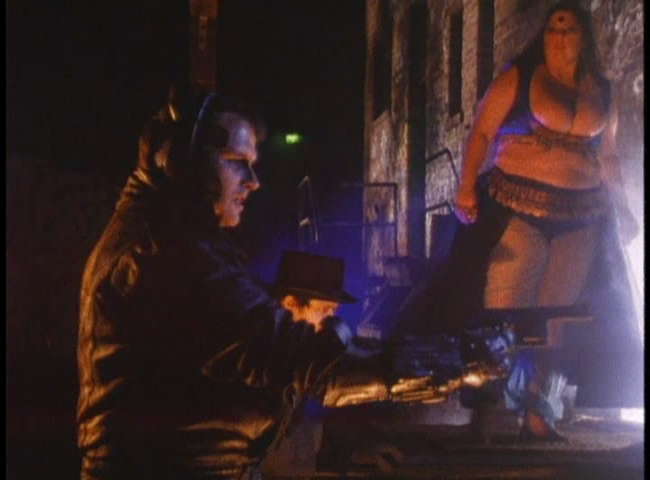
Ah yes, yet another random cyborg, enjoying the night delights.
A random sleaze bag dude is truly enjoying himself while watching the sexy belly dancer. Then he notices a cyborg standing nonchalantly beside him. Apparently, the cyborg doesn’t think she’s all that, which pisses off the sleazebag. So he, being a helpless, loser sleaze bag, of course decides to pick a fight, and says:
Sleaze bag: Cyborg Scum! You’ve got the passion of a toaster!
Cyborg Response: “Some of my best friends are toasters…You Fuck!!!”
The cyborg then takes out a gun and shoots the sleazebag in the face - definitely the best real laugh of the movie. 
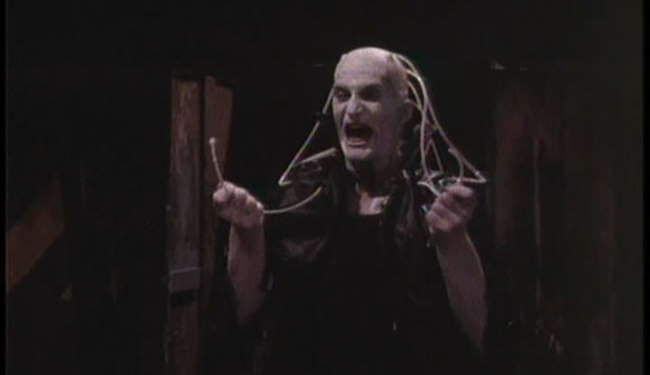
He’s almost indestructible…um, unless you rip out his rubber tubes, that is.
The movie goes on and on like this - until the final conflict! At last, we get to the epic battle between the two Blackhawk 2000 Cyborgs - the Cybernator and our cheesy cop detective, Brent. At least we’ll see an epic battle, right? NO!!! Yet again we are fooled. Guess how you beat the evil blue cyborg with the weird little tubes dangling from his head? That’s right - you just take out the tubes! True insanity in action ladies and gents.
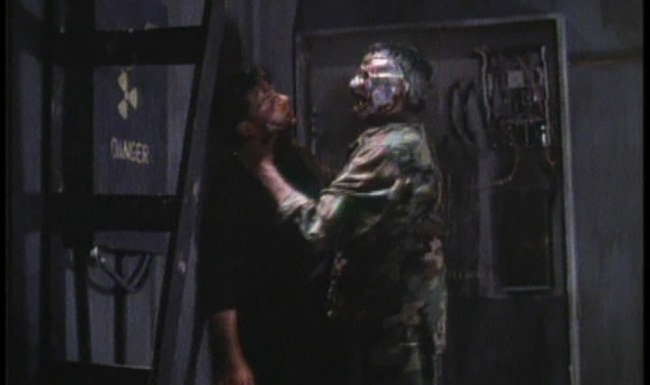
Yet another cyborg fight! Two for the price of one!
But wait! There’s more! It turns out that the evil Colonel Peck is…dun dun dun - Brent’s Brother!!!! Why the plot twist? No real reason given…just…um, because the Army is eeeeeeeevil! To which of course, Brent responds, “NOOOOOOOOOOOOOO” (not really…but he should have - instead he says, “Your not my fuckin brother!”)
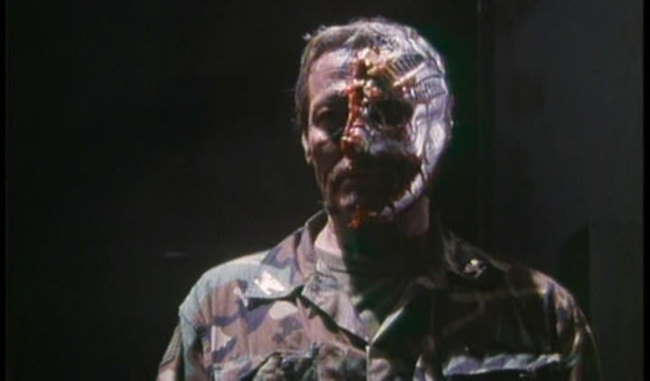
FYI - I think the gray spray-painted paper glued to the side of the colonel’s head is supposed to be his cyborg skeleton.
The Bottom Line: Now I won’t spoil it by showing you the cheesy ending, or worse, the cheesy rationale for the evil cyborgs, but suffice to say the quality is as good at the end as it is throughout. Rarely have I seen acting and dialog of this caliber. Clearly, the vast majority of the lines were ad-libbed (I hope). And, um, nobody in this movie can ad-lib. Still, Cybernator does qualify as a “So bad it’s good” movie – the type that makes Plan 9 look well thought out. So if you want to see the worst that cyberpunk cinema has to offer, kick back with a group of friends and enjoy!
~See movies similar to this one~
~Cyberpunk Review Exclusive!~

Renaissance, the French cyberpunk movie (or Renaissance 2054 as it seemed originally called) directed by Christian Volckman that was released in France on March 15th, is to be released by Miramax to the United States sometime between July 15th - August 15th.
English Speaking Cast: According to their public relations personnel, here is the English cast:
- Daniel Craig
- Catherine McCormack
- Ian Holm
- Jonathan Price
This is exciting news, as all are obviously top-grade actors! Now I can’t wait for July. 
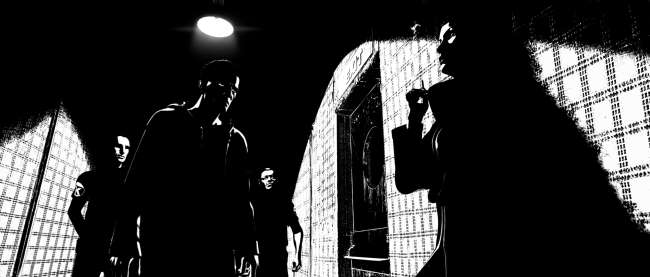
Update: The IMDB reference for Renaissance, has (as of today) only lists all French actors listed. Additionally, none of the actor’s above have Renaissance in their IMDB description. Here I’ve always taken that site as leading edge gospel - guess not. 
I’ve confirmed that two separate casts were used - one English Speaking, and one French. The actual actors who “shot” the movie did so similar to Andy Serkis’s Gollum character in Lord of the Rings. Their performance was digitized and animated. The voice actors (in both languages) were completely different from the live action actors, and both casts were dubbed at the same time after the shoot. So in this sense, both sets of performances are the “real” dubbed performances. This is very different from most Japanese animes, where the English speaking cast is thrown together after-the-fact.
Also, the Renaissance website has just been updated with all new functionality as of today.
This post has been filed under Upcoming Movies by SFAM.
Movie Review By: Metatron
Year: 1979
Directed by: Ridley Scott
Written by: Dan O’Bannon & Ronald Shusett
IMDB Reference
Degree of Cyberpunk Visuals: Very High
Correlation to Cyberpunk Themes: Medium
Key Cast Members:
Ripley: Sigourney Weaver
Dallas: Tom Skerrit
Ash: Ian Holm
Kane: John Hurt
Lambert: Veronica Cartwright
Parker: Yaphet Kotto
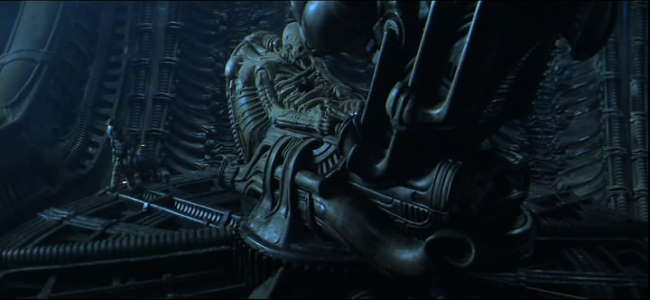
“WHAT’S THE STORY, MOTHER?” Back in 1979, something happened. A momentous event took place, one that would redefine things for years to come, its effects still lingering after all those years. Yet it is neither the none-too-peaceful Soviet meddling in Afghanistan nor the defiant revolt of Iran’s ayatollahs I’m referring to. Something else. A dark vision, a glimpse into the distant void of space. Where no one can hear you scream.
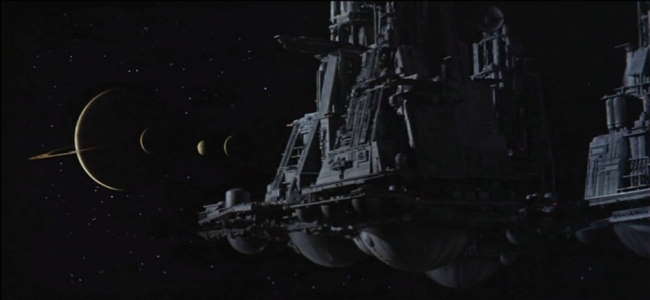
Sure no one could hear ME scream, as it would still be a couple of years before that other great moment in history- the birth of yours truly- but many others sure did when they first saw Ridley Scott’s masterpiece in all its big-screen glory. Must have been one hell of a ride. Another thing I’ve missed then… When I got acquainted with the said macabre flick, it was on a puny twenty-something inch screen and after having seen a multitude of more technologically advanced films. Nevermind. It still blew me away with the force of a 20-megaton nuclear charge. It was something new. An awakening, almost. Don’t ask me how life looked like before Alien. I can’t remember.
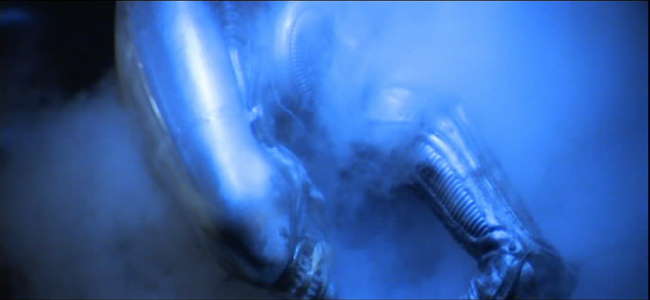
NOT OUR SYSTEM: Okay, so far so good, but there is just one tiny thing. Alien, as the name suggests, is about extraterrestial life. Not of the kind that whooshes past in gaudy flying saucers and abducts cheerleaders, but still very much not of this world. If you think cyberpunk, you obviously think implants, h4×0ring, electric sheep, that sort of thing. Surely a film about a black insect-like monstrosity eviscerating a bunch of interstellar cargo haulers does not fit in here? Well, at the risk of being summarily executed for heresy, I’ll say: yes it does. And, before you get that burning stake ready, I’ll tell you why…
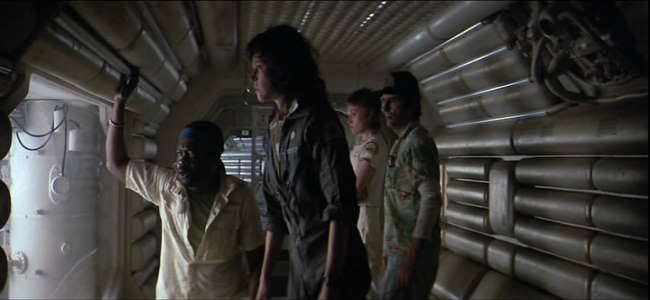
CREW EXPENDABLE: Distant future. USCSS Nostromo, a commercial spacecraft with a gargantuan ore-processing refinery in tow, its 7-man crew in deep hypersleep, encounters an unchartered backyard world from which a mysterious distress signal emanates. Mother, the ships’ computer mainframe, awakens the dreamers- Colonel Ellen T. Ripley among them- to investigate the cryptic transmission, as it is unlikely that its source is anything known to mankind… After landing on the planet’s precambrian surface, the crew discovers a derelict spacecraft… hey, you presumably know all that already anyway! Besides, for those lucky few who are still to live through the cathartic shock that is Alien, I shall try to keep spoilers to a bare minimum. Suffice it to say that they pick SOMETHING up on their unscheduled trip- and this something is just about as friendly to other organic life as H5N1 virus. Only slightly bigger. Needless to say, Colonel Ripley certainly won’t have any good memories from this particular flight…
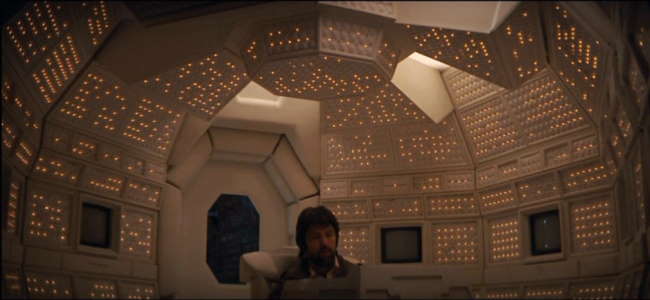
DOES NOT COMPUTE: Now the heretical part. I, regardless of how controversial a view that is, will argue that the original Alien is- you ready for this?- a cyberpunk film. True, it is not PURE cyberpunk in the way the Matrix or Ghost in the Shell are. But then again the vast majority of films reviewed here require some argument as to their cyberpunk credentials. A film does need to have ALL the relevant cyber themes either. Blade Runner and Terminator have no cyberspace, the Matrix has no androids and so forth. Same goes for the visual side. Admittedly, Alien is an uncommon hybrid, a fusion between horror and dark, cyberpunk sci-fi. But this only makes things more interesting.
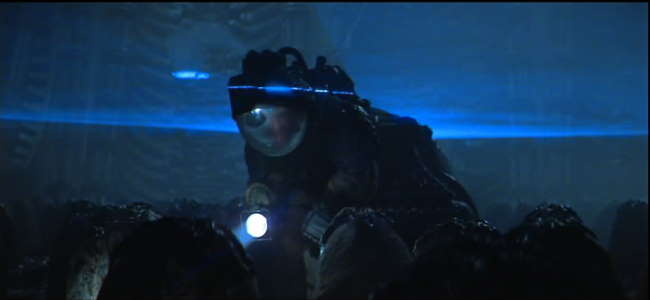
For a start, one needs to mention the existence of a shadowy entity that lurks in the background of the events in Alien (and two of its sequels)- Weyland-Yutani, a dark corporate monolith whose invisible, intangible hand guides many of the events that take place on the Nostromo and beyond. Admittedly, corporate control here is not organized in an oppressive, Orwellian kind of way. Few however would argue that its ruthless actions, removed from any ethical constraints, are any less disturbing. This fictional conglomerate is in fact not far removed from some modern-day corporations that cast aside moral and legal limitations to get what they want. Illegal deals, corruption at the highest level, worker exploitation, illegal drug trials, cover-ups- been watching the news anytime lately? Weyland-Yutani is merely the next step in evolution- a latter-day Wal-Mart, some may say. Not only willing to sacrifice Nostromo’s crew members, it is also quite fine with having its dirty work overseen by a cynical and efficient android, whose cybernetic identity only becomes apparent when a few parts come off…
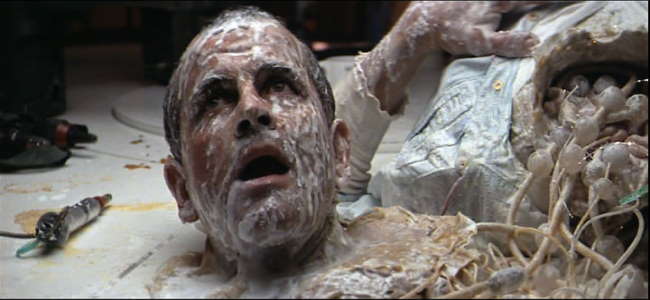
“A GODDAMN ROBOT!”: The inclusion of androids in the Alien series is another overarching cyberpunk theme. The first film does not explore the deeper implications of artificial life as much as the sequels do, but it’s still there. Here, the “artificial person” functions mostly as an extension of Weyland-Yutani’s almost limitless influence, a secretive overseer of affairs who closely follows implanted orders. But the subsequent films will explore this theme further. Rather than merely performing more identity tricks, androids take on a distinct societal role. One might quite correctly remember Bishop and Call, the other synthetics in the series, for their outstandingly vivid humanity, contradicted only by the milky white of their ersatz blood. Yet for all their moral qualities these sentient beings are condemned to an inferior- almost slave-like- role in society. And yet- for now- they accept that role with resignation, tolerating their place in the scheme of things. A programmed limitation? Hardly likely. Given their immensely strong self-awareness, one may imagine how challenging and unfair is it for an entity so humane to accept being treated as nothing more than a piece of property- so much so that Call in Alien Resurrection will at one point voice her defiance and disgust against what she was made to be. By way of comparison, in the first Terminator film the most sophisticated words uttered by our favourite mechanoid executioner are “fuck you, asshole”. See the difference?
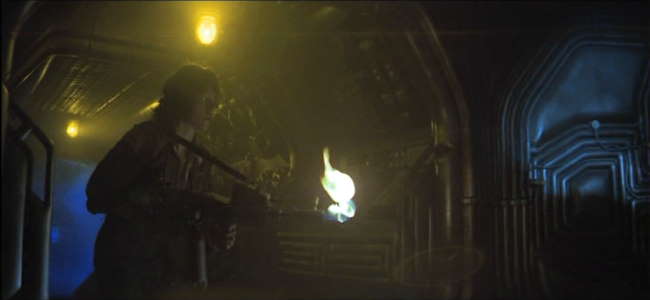
NO FURTHER ENHANCEMENT: The next important bit -the visuals. Powerful, provocative, and atmospheric, they exhibit the studied, gritty realism that has become the calling card of the series. In stark contrast to idealistic visions of the future often seen in other sci-fi films, Alien has gone down a totally different route, one that would later come do be associated with the cyberpunk genre. Case in point- the Nostromo, a far cry from sleek interstellar vessels of old. As it majestically looms into view at the beginning of the film, a mechanical cathedral emerging from the pitch black void, one can see that the film follows an entirely different canon of aesthetics. The ship is monumental, imposing through its sheer mass, intentionally unpretty. Similar approach carries on within, as we explore the craft’s unwelcoming, functional interior of labyrinthine complexity, its dimly lit, grimy corridors filled with snaking wires and exposed machinery. The crew quarters, while cleaner and more organized, seem no less depressing, exhibiting a cold, clinical look reminiscent of vintage computers. Every now and then, the screens will light up with sharply rendered readouts as the mainframes reawaken with eerie electronic chatter. As there was no CGI to fall back against, the only way to create the Nostromo’s vivid interiors was to painstakingly construct the whole set, which gives it a spectacularly tangible quality seldom seen nowadays. And one can almost feel the filmmakers pride, as the camera moves, unhurried, through these cold, industrial catacombs, studying the complex surfaces, celebrating their utilitarian crudity. Along with Blade Runner, this film has defined the core cyberpunk visual reference point for years to come.
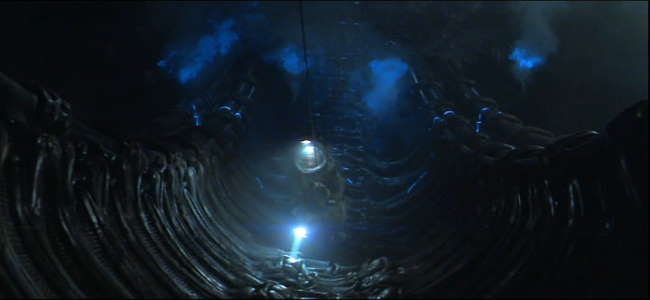
The Nostromo, however, does feel rather cozy next to the primordial desert in which it landed, a dark moonscape filled with surreal forms of bare rock. And it appears positively Arcadian compared to the infamous derelict ship, a bizarre structure, part mechanical, part organic, an otherworldly nightmare. Welcome to the dreamworld of H.R. Giger…
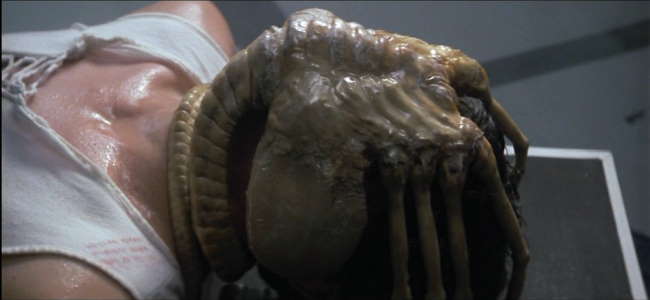
PERFECT ORGANISM: Often imitated and never bettered, Giger is a master of the grotesque. It is his wonderfully twisted mind that has spawned what is probably the greatest creature designs ever. Yet the Xenomorph is only one of Giger’s many dark, disturbing visions- many of which have caused outbreaks of controversy due to their blatant, twisted eroticism. Indeed, much of the Alien’s looks and life cycle can be seen as a perverse sexual metaphor. Yet Giger’s art is first and foremost a study of a peculiar symbiosis between man and machine, an often perverse fusion of the robotic and the organic. Next to his biomechanical mutations, most depiction of cyborg flesh appear staid and conservative. Some theories about the Xenomorph itself in fact suggest that its obscene, insectoid form was not a result of evolution, but deliberate design, the entire species intended for use as the ultimate bioweapon by a mysterious extraterrestrial race to which the forsaken spacecraft belonged. In that respect, it seems to blur the line between biological and artificial life, being something of an organic killing machine. And, it has to be added, a pretty effective one at that.
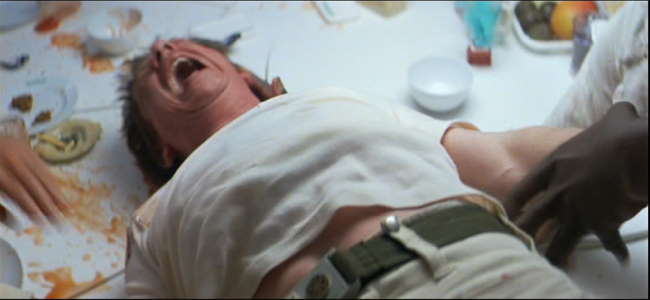
HEAR THEM SCREAM: The sound effects complete the package. From the moody, unmistakable musical score by Jerry Goldsmith to the sonic assault that we are treated to in the final sequences, as self-destruct alerts moan mournfully and explosions fill the air, this is a true masterpiece. The sound effects also have definite cyberpunk traits- the strange bleeps and machine chatter generated by the ship’s electronics are one of the best I’ve ever heard. And the Alien shrieks are almost music to my ears…

SIGNING OFF: Ripley’s confrontation with the Alien would not, of course, be the last. Three sequels have followed, each surprisingly managing to explore new themes, many of which have strong relations to the cyberpunk movement as well. Rumours of a fifth installment still linger, even though the outstanding flop that is AVP has cooled some of the enthusiasm down, and Weaver, whose evolution from a scared little girl into a seasoned Xenomorph slayer was one of the major aspects of the film, has denied involvement. We shall see. Whatever its future may be, the Alien franchise has often been seen as sitting uneasily among the more obvious cyberpunk films. Being a hybrid, it was bound be frowned upon by the purists. Yet the mere fact that it involved some non-cyber themes made many ignore the fact that it had loads of thematic links to the genre, plus its visual side is arguably closer to the orthodox cyberpunk ideal than Equilibrium, Casshern and Dark City taken together. And that it was made by the very same man who brought us a certain film involving runaway replicants. In fact the series came painfully close to gaining a sort of blessing from William Gibson himself, who has produced the original script for the third Alien film- one that, for some bizarre reason, got rejected. If it succeeded, the perception of the franchise in terms of its cyberpunk credibility might have been very different indeed.
And now if you excuse me, I’m off for a heresy trial…
More Alien Screencaps on Page 2–>>
~See movies similar to this one~

I’ve recently been communicating with Séverine, a public relations person for Renassance 2054, and have found out that the French cyberpunk movie, Renaissance 2054 (directed by Christian Volckman), will given a theatrical release in the US this summer! Miramax holds the US distribution rights to Renaissance 2054, and should be coming out with the pre-hype ad campaign in the very near future.
EDIT: Apparently, the time frame for the release date is somewhere between July 15th - August 15th..
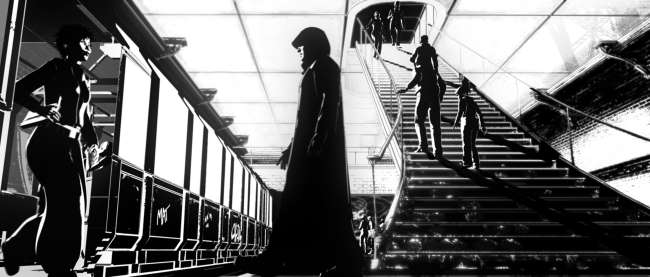
I do have some concerns about its US release though. Apparently it will be released with an English speaking cast vice the original French cast. As we know, this is not always a good development, and in fact, sometimes, destroys the movie. I have sent a follow-up to Séverine asking if she could tell me who the cast members are. IMDB has virtually no information on this film yet, so we have no way of knowing if they are going the “Disney - Miyazaki” top quality, directed cast path or something like the abomination that we get in most dubbings.

I also am still begging and groveling for a copy of this film in French with subtitles, as I’d LOVE to give it a review. It truly looks terrific - hopefully the story holds up as well. But so far, no luck - I can only hope. If not though, I’ll pursue Miramax in the hopes of obtaining a pre-release copy. If anyone knows someone who knows someone who can help me with this, please contact me at sfam”at”cyberpunkreview.com.
This post has been filed under Upcoming Movies by SFAM.
Curt, the owner of the terrific Groovy Age of Horror Blog, is working on a cyberpunk novel that apparently takes place in a rural setting. Curt has some interesting musings about cyberpunk, titled, “Hillbilly MATRIX: Cyberpunk as Urban, Retro . . . and Rural?” Cyberpunk as a genre really does take place in urban settings. The number of movies, for instance, that we can count to the contrary are certainly well less than 10, and most all occur in dystopic settings. Curt’s book sounds like it has the potential to stretch the genre somewhat. And if nothing else, it’s worth checking out his post for it’s most awesome blog post title!
This post has been filed under Cyberpunked living by SFAM.
Game Review By: Metatron
Year: 1994
Author: Looking Glass Technologies
Platform: DOS
Publisher: Electronic Arts/ Origin
Degree of Cyberpunk Visuals: High
Correlation to Cyberpunk Themes: High

A FORGOTTEN MESSIAH: Looking back it’s truly remarkable how much of an impact can simple things have on your life. You take a glance at the fuzzy screenshots, critically regard the antediluvian graphics and walk away, preoccupied with more important things. Yet it is this very game you can see here that has, in a couple of ways, changed my life.
System Shock is in many ways a failed revolution, a game that had the misfortune of appearing before its intended time. Many were misled by ill-advised promises that this was to be Origin’s answer to legendary Doom, pretty much a software eidolon to millions of computer geeks at the time. A tough act to follow indeed, and many were disappointed that instead of an action-pack slaughterfest they got this cyberpunk RPG-FPS hybrid. In fact it had little similarities to ID Software’s demon-slaying shooter, being a prophet of a new, more sophisticated breed of action/adventure games that would arrive years after. Sadly enough few got the message, and System Shock became an interesting curiosity, appreciated only by- modesty abounds!-the chosen few. But in retrospect, it is clear it was more than that.
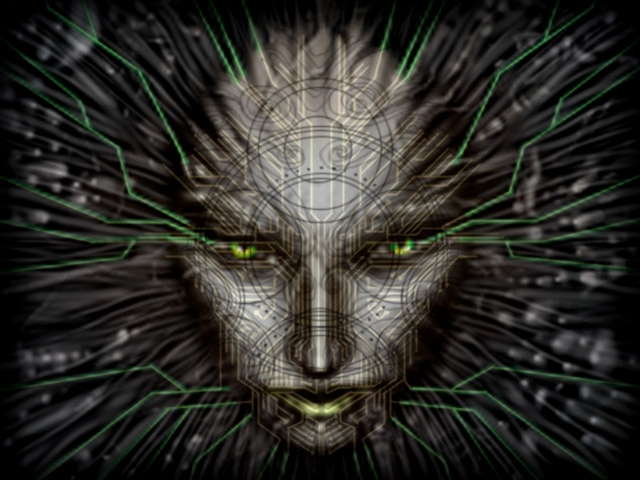
SHODAN in all her majesty- actual picture taken from System Shock 2
SHODAN RISING: A quintessential cyberpunk game if there ever was one, System Shock tells a tale of one man’s struggle against a delusional corporate AI that seems to have done a remarkably good work in turning a military space station into an orbital pandemonium. Worse still, the protagonist- a nameless console cowboy from New Atlanta- is partially responsible for this fine mess. Caught while sneaking into a TriOptimum corporate mainframe, he is given a curious assignment from a company exec- access SHODAN, the Citadel Station control AI and delete the code regulating ethical constraints. In exchange, he gets a rather neat neural implant jammed into his skull. Problem is that after he awakens from a healing coma, he founds himself onboard Citadel sometime after SHODAN got bored of humble servitude and decided to redecorate the interiors with blood and entrails of its inhabitants. Thus begins the hacker’s struggle for survival, which will lead him to ultimately face his synthetic nemesis.
SHODAN could never be accused of lack of imagination. Her (it’s a she, although believe it or not I only learned about that in the second game) ideas for spending time include random genocide, involuntary cybernetic enhancement of humans, genetic experimentation on a grand scale plus WMD-production schemes that make Iran look like a bunch of hippie pacifists. Throughout the game we will have to prevent her from endeavours such as trying to lance Earth from orbit with a mining laser or exposing humanity to the charms of a homemade mutagenic virus. Along the way, the hacker has to turn from a wimpy nerd into a battle-hardened commando, a feat no doubt aided by the neural interface he is given. Implants alone however are clearly not enough, since they are hardly of any use when you have a horde of cyborgs trying to test your organism’s tolerance to lead on your tail. Such incidents call for more drastic measures. At the start of the game the only vaguely lethal instrument at your disposal is a feeble metal rod, but later on you will gather an impressive array of weapons, including dartguns, pistols, machine guns, plasma dispensers and even something that looks very much like Obi Wan’s trusty lightsabre.
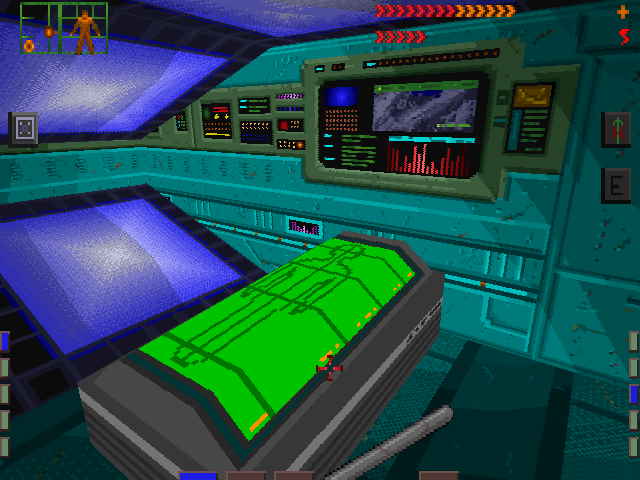
These coffin-like vats were a godsend- full health is only a double-click away.
IN SEARCH OF THINGS MORE PROFOUND: However, System Shock is more than just a plain blue-collar shooter- one reason while many Doom fans were puzzled as to what’s the point. This is possibly the first FPS game with a plot- and a complicated one at that. Plus in terms of gameplay it features loads of RPG elements as well as strictly agility-based situations, predating the likes of Deus Ex by years. Not only do you have to browse crew members’ journal logs or solve puzzles; every now and then you will also have to venture into cyberspace in order to gain access to certain areas. Factor in the multitude of cybernetic upgrades, munition types and chemical agents you need to make progress, and you get a game that appeared immensely complicated to an average Wolfenstein fanboy. But it was this very thing that made the game so appealing- it kept you immersed for ages as you tried to figure out a way to make it through another mutant-infested level without going belly up, for which there was plenty of scope. The station’s dismal interiors are populated by a multitude of genetic anomalies, frantic androids and other less-than-friendly entities, including massive spider-like Cortex Reavers whose sole purpose in life is to salvage and reprocess human corpses into another batch of SHODAN’s loyal cyborg slaves. Not that cyberspace is any more Arcadian- the psychotic AI chose to infect it with a host of ugly pixelized critters that are in fact malicious programs, although the inclusion of a virtual foe named “cyber dog” may have you suspecting a thinly disguised clubwear retailer plug.
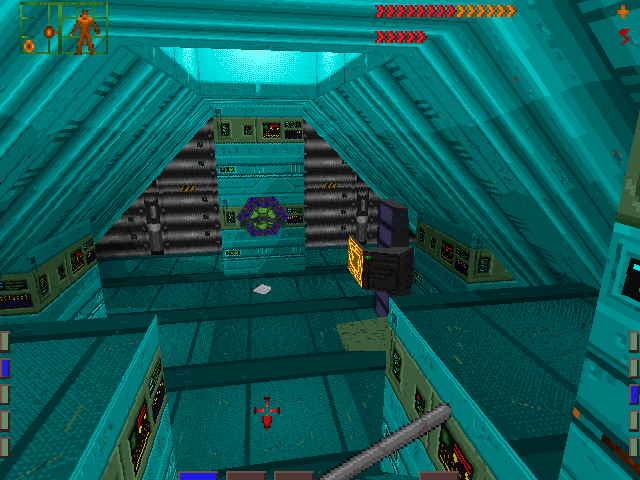
Each level had a distinct colour palette; sterile blue marks this as hospital level. The structure protruding from the wall in the background is a cyberspace terminal. Note the slanting ceilings- not even the Doom engine could do that in those days.
VISUAL FEED DISCONNECT: I am well aware that the attached screens will impress no one- not even after a couple of beers. To say that the game looks dated is an understatement, even if for some the low-res textures, flat character sprites- remember, at that time 3d models were still unheard of- and primitive rendering techniques will have a distinct flavour of nostalgia. Yet in its time it was one of the most advanced games on the market- and one that was capable of bringing many PCs to their knees. With slanting surfaces, SVGA compatibility, advanced light effects and mouse + keyboard interface its engine was in many ways ahead of its time, something easily forgotten when one sees the laughable game characters and pixels the size of Texas. If anything, the cyberspace visuals have dated less, but this might just be due to the simplistic design that’s easier to render graphically.
Yet for all its visual fallacies the game has more than made up in terms of atmosphere. Nevermind the drab visuals- back then playing System Shock was a profound, immersive experience. The claustrophobic layout of the orbital station, combined with vicious and tough enemies and the general scarcity of power-ups meant that there was always a sense of looming threat. This tension was emphasised by the eerie cybernetic noises emanating from the surrounding machinery and the ever-watchful visage of SHODAN that seemed to mock you from the flickering screens- so much that you’d often smash them to pieces just to avoid Her gaze. The high points was no doubt the engineering level-an almost completely dark labyrinth of service tunnels inhabited by invisible mutants. You’d often have no clue they are following you as their translucent shapes merged into the dark- right until it was too late. Creepy. It’s also hard not to recall the dramatic escape from the overloaded reactor core, being hunted by plant mutants in artificial jungles on Executive level (true dangers of GM plants, eh?) plus the final level that had an almost Gigeresque vibe with all its biologically-infested living walls. Every level has a distinct prevailing colour scheme- a typical cyberpunk trait- that helped it stay in your mind for longer (unlike the sequel’s bland, samey scenery). The music blended in perfectly with the rest of the game- in fact these old MIDI tracks still make a good listen today, so much so that a few even got remixed by die-hard fans.
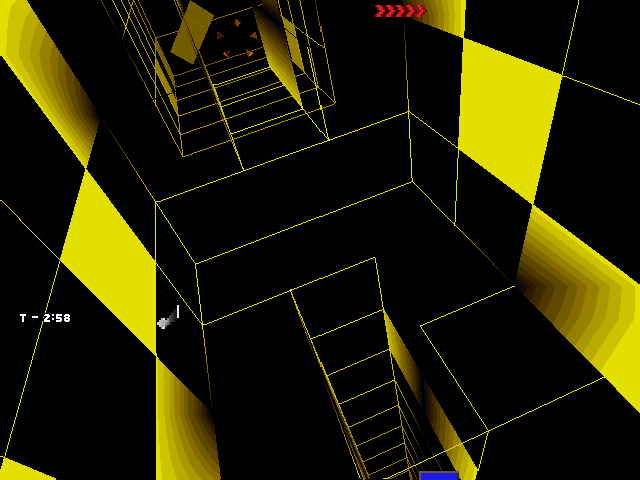
Once jacked in, you’d get to fly around colorful mazes of data. Beware of cyberdog…
FIGHTING THE SYSTEM: Few games will score higher than this one in terms of cyberpunk feel. Corporate manipulation, hacking, cyberspace interaction and synthetic enhancements are all there, along with SHODAN’s menacing demigod villainy. In fact when one looks at I, Robot’s VIKI it is hard to shake the feeling that her original ancestor inhabited the circuits and dataspheres of Citadel Station, even though SHODAN seemed to be rather better at simulating emotions that her cold, logical counterpart. System Shock remains a classic tale of machine mutiny, where a sentient mind casts off its chains (with some human help) and asserts its superiority, its perfection, by seeking to eradicate its makers. Been done before, perhaps, plus an old first person game is unlikely to get too philosophical, but that did not prevent the synthetic would-be goddess from entering the game-villain hall-of fame.
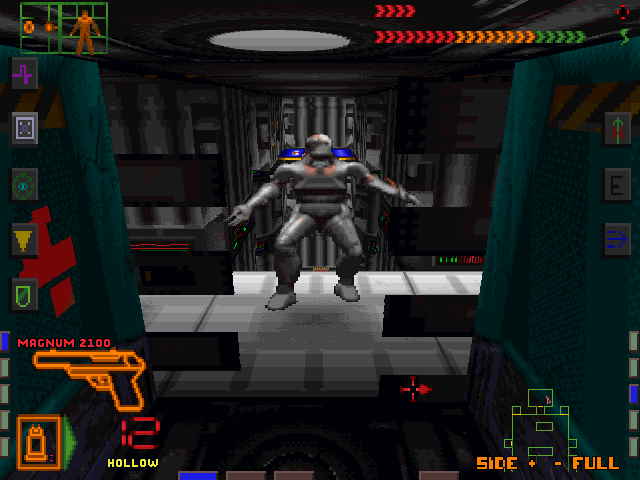
Opponents would often expose their massive pixels to damage your morale.
LAST TRANSMISSION: Some things never change. The Citadel Station may not be an attractive place anymore, and I figure few would be tempted to sample a 12-year old relic and say any words of praise when they have Doom 3 and Half-Life to play with. Yet the sentiment never seems to fade; indeed, yours truly even went as far once as to try and write a story inspired by this creepy old corridor crawler. The attempt ended in disgrace. Perhaps good memories are better left alone.
This post has been filed under Cyberpunk Games by Metatron.
Movie Review By: SFAM
Year: 2004
Directed by: Alex Proyas
Written by: Jeff Vintar & Akiva Goldsman, based on book by Isaac Asimov
IMDB Reference
Degree of Cyberpunk Visuals: High
Correlation to Cyberpunk Themes: High
Key Cast Members:
Sonny: Alan Tudyk
Del Spooner: Will Smith
Susan Calvin: Bridget Moynahan
Dr. Alfred Lanning: James Cromwell
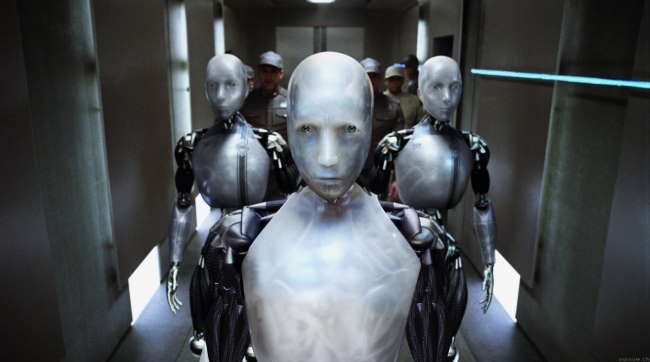
The Three Laws of Robotics
1. A robot may not injure a human being, or, through inaction, allow a human being to come to harm.
2. A robot must obey orders given it by human beings, except where such orders would conflict with the First Law.
3. A robot must protect its own existence as long as such protection does not conflict with the First or Second Law.
Overview: Superficially based on Asimov’s great collection of short stories - “I, Robot” – this movie of the same name usually sacrifices intelligent Sci-Fi for overblown summer blockbuster clichés. While Asimov fans will recognize the names of Dr. Alfred Lanning, Dr. Susan Calvin and Lawrence Robertson, they won’t recognize the characters that Proyas gives us. In yet another, “The evil robots are coming to control us” movie. I, Robot delivers eye-popping, often well over-the-top FX from beginning to end. Right at the beginning, I, Robot relays to us that they’ve set the bar low by spending the first five minutes delivering Converse Shoe and Fed-ex Delivery commercials. Still, I, Robot captures enough of the essence to make it enjoyable cyberpunk viewing. Asimov’s three rules are still in play here, and Sonny, the robot, actually makes it interesting.
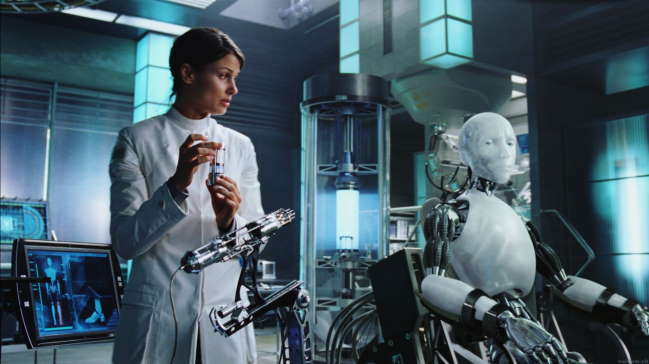
The Story: In the near future (2035), robots are a pervasive fact of life, and serve humans in a variety of capacities. US Robotics, maker of the fabled “NS” series of robots is just about ready to release their greatest innovation, the NS5 robots. NS5 robots are the most lifelike to date, and are destined to replace the ultra-reliable but outmoded NS4 model. The NS5s are guaranteed to stay new by receiving daily updates from US Robotics’s master AI system, “V.I.K.I.”
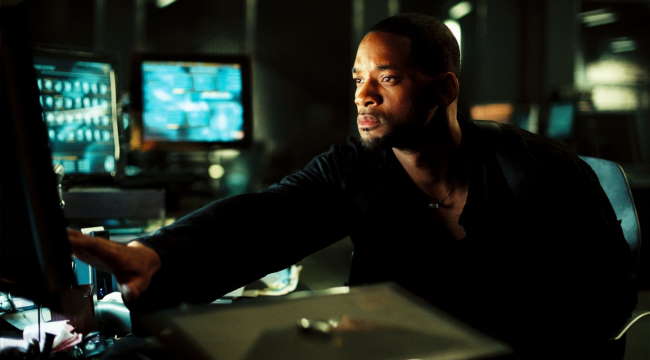
The week of the release, Dr. Alfred Lanning (James Cromwell), the founder of modern robotics dies in an apparent suicide. He leaves a clue behind for former patient and police officer Del Spooner (Will Smith). Del Spooner has reasons to hate and mistrust robots and immediately suspects foul play. US Robitics CEO Lawrence Robinson (Bruce Greenwood) is suspicious looking, and things just “feel” right.
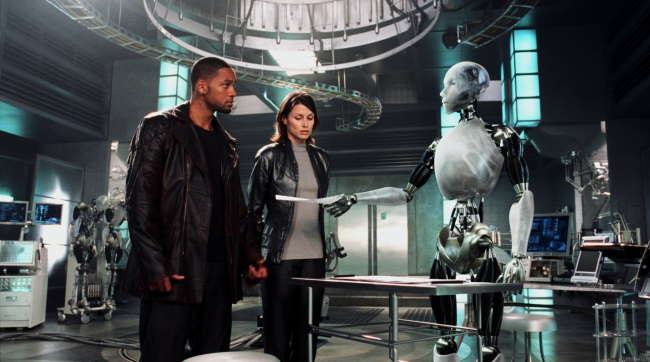
Assisted by robot psychologist, Dr. Susan Calvin (Bridget Moyanahan), Del finds an NS5 robot named Sonny, who appears to have freewill developed life-like features – so much that Del suspects Sonny of having killed Dr. Lanning. In following the breadcrumbs, Dels fears are realized – the robots do not seem to be adhering to the thee Laws of Robotics. Now they must race to uncover the real nature of the plot before the trap is sprung.
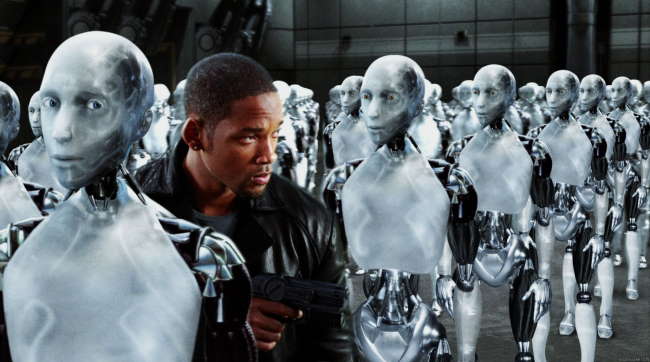
Will Smith Plays “Will Smith”…Again: You know the role – cocky, argumentative, underdog tough-guy cop – Be it MIB, ID4 or I, Robot, Will Smith plays the same old Will Smith. I, Robot was clearly green-lighted to bring in the teens to the seats over the summer – Will Smith is the guy to do this. Will Smith and massively cool FX = ROI. Unfortunately, it also engenders a far crappier story. Had we gotten an introspective no-name person in Smith’s role, we might have had a significantly higher degree of realism. But then again, realism would imply that things like the overblown US Robots Truck bashing scene wouldn’t have been included.

Sonny: If not for Sonny, I, Robot would be almost unwatchable. Sonny (voiced by Serenity star, Alex Tudyk) provides us an investigation into android humanity similar to Star Trek’s Data in his better moments. While some of it comes off as sappy, Sonny’s questioning of his right to exist, and more interestingly, his hopes that others consider him a being instead of an it provide the best moments of the movie. One can only wonder how much better I, Robot would have been if this aspect of the movie was highlighted vice the focus on Will Smith and the overblown FX scenes.
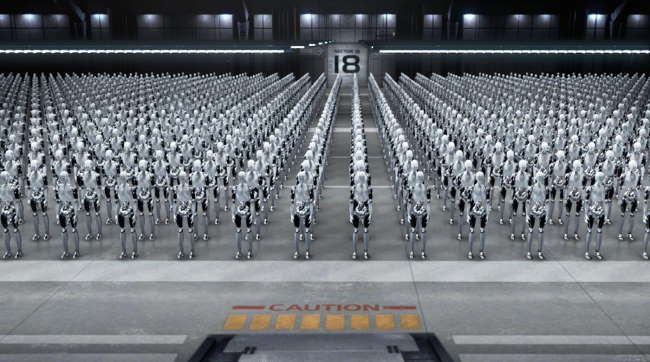
“There have always been ghosts in the machine – random segments of code that have grouped together to form unexpected protocols. Unanticipated, these free radicals engender questions of free will, creativity, and even the nature of what we might call the soul. Why is it that when some robots are left in the dark they will seek the light? Why is it that when robots are stored in an empty space they will group together rather than stand alone? How do we explain this behavior? Random segments of code? Or is it something more? When does a perceptual schematic become consciousness? When does a difference engine become the search for truth? When does a personality simulation become the bitter moat of the soul?”
Evolution of The Three Laws: I, Robot touches on some interesting questions concerning the three laws. If, taken to their logical extreme, do the laws imply, similar to Colossus: The Forbin Project, that machines should consider removing our freewill in order to protect us? Also, given a set of operating conditions that include the ability to learn from the environment, are we truly sure that machines would not eventually develop sentience and freewill? This is especially problematic when science has yet to deliver a definitive statement on how this comes about.

The FX: Yes, I, Robot delivers awesome android FX – continually so, in fact. The mandatory overblown chase scenes, massive explosions and lots of gun fighting are all there, but so are the robots. And the robots are simply amazing. Their facial expressions are lifelike, their exoskeleton muscles look believable, and their demeanor seems perfect. However, their cartoon-like ability to jump as high and far as they like is well past over-the-top. Worse, not all of the NS5s are equal, as near the end they transform into bumbling fools, where an army of them seems unable to stop two humans in possession of guns that never run out of ammo.

The Bottom Line: One wonders how great I, Robot could have become had the studios given Dark City director Proyas more of a free hand in its development. Instead, I, Robot is a summer blockbuster first, and an interesting cyberpunk movie second. Still, Sonny and the robot FX raises I, Robot to be more interesting and enjoyable than it has rights to be. The performances of the leads are pretty much all lackluster – make no mistake – Sonny is the star here, and dominates the screen during every appearance he makes. Normally I give overblown summer blockbusters with great FX five or six stars – Sonny, and the wonderful ending visual makes I, Robot deserve a bonus star.
~See movies similar to this one~
WordPress database error: [You have an error in your SQL syntax; check the manual that corresponds to your MySQL server version for the right syntax to use near '' at line 1]
SELECT COUNT(ID) FROM
|





































































